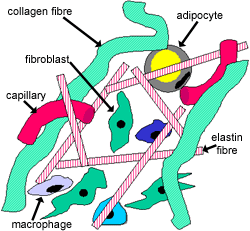Cartilage and Bone: Basic Structure

Cartilage and bone are both modified rigid forms of connective tissue, which was covered in the topic on tissue types.
Connective tissue has two main consitutents - cells and extracellular material.
As discussed in the section on connective tissue; the extracellular material determines the physical properties of the supporting tissue. Extracellular material (ground substance) contains glycosoaminoglycans (GAG), fibres and structural glycoproteins.
Remind yourself in more detail about the extracellular material of connective tissue in general
Cartilage is a strong, flexible and semi-rigid supporting tissue. It can withstand compression forces, and yet it can bend.
- It is important in forming a template for the growth and development of long bones. And cartilage persists in regions such as the ends of bones (articular cartilage), the walls of airways (nose, trachea, larynx and bronchi).
- The GAG is chondroitin sulphate, which is rubbery, and provides cartilage with resilience,
- The fibres are either collagen, or a mixture of collagen and elastin fibres which provide cartilage with tensile strength, and elasticity respectively.
Find out more about cartilage.
Bone is rigid, mainly because the extracellular matrix is calcified.
Find out more about the properties of bone.